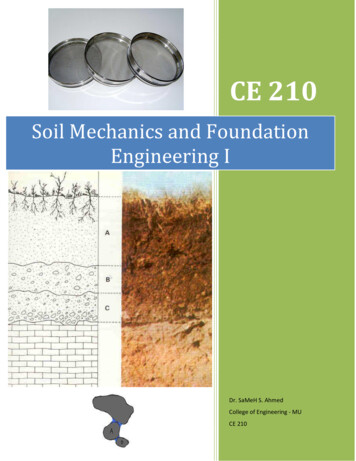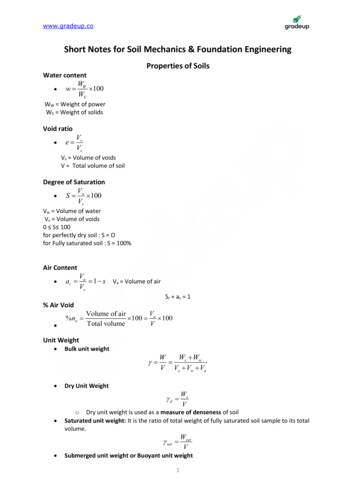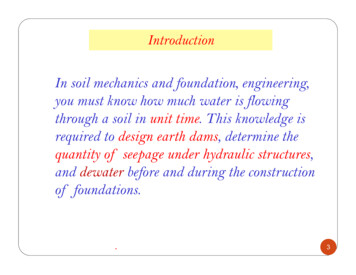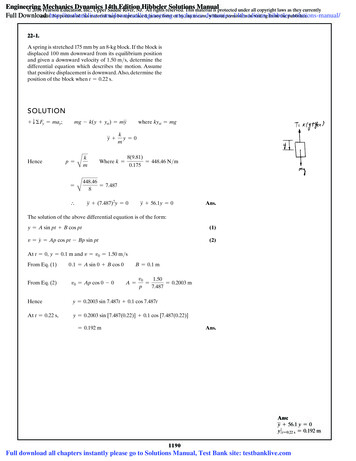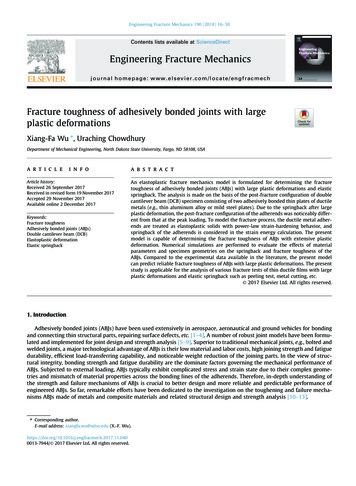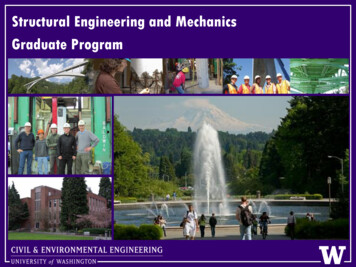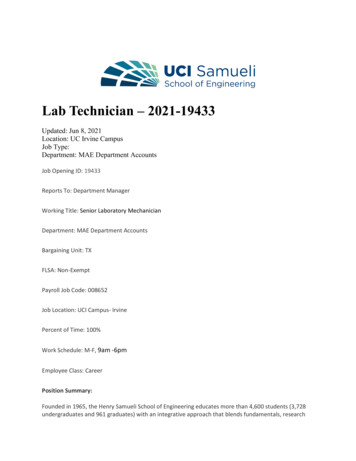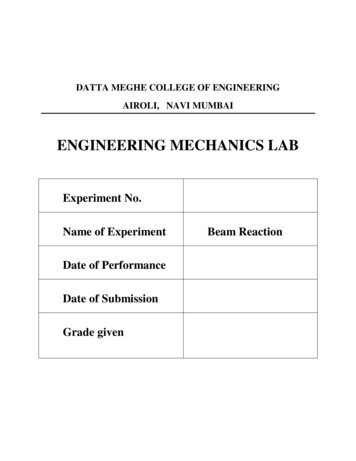
Transcription
DATTA MEGHE COLLEGE OF ENGINEERINGAIROLI, NAVI MUMBAIENGINEERING MECHANICS LABExperiment No.Name of ExperimentDate of PerformanceDate of SubmissionGrade givenBeam Reaction
EXPERIMENT NO.-BEAM REACTIONAIMAPPARATUS:-To verify the condition of equilibrium by finding reactions at thesupport of a beam.:- A Calibrated beam supported on The compression balance, weights,and hangers.DESCRIPTION :- It consists of a wooden beam having equivalent grooves across itslength at 10cm intervals. The beam is supported by 2 balances. Thedistance of the weight from the support can be suitably adjusted.The experimental values of the reaction can be directly known fromthe balance.THEORY: - The condition of the equilibrium are:1) The algebraic sum of the horizontal components of all forcesmust be zero.2) The algebraic sum of vertical components of all forcesmust be zero.3) The algebraic sum of moment of all forces about any pointmust be zero.PROCEDURE:1. Study the working of the apparatus.2. Note down the zero errors if any.3. Note down the self–weight of the beam.4. Apply weighs on hangers from left & hold down the positionfrom the left hand support.5. Take five such readings carefully at different points,different reading with different position of load.6. Calculate reading on the support by applying condition ofequilibrium.
OBSERVATIONS : 1. Self weight of beam N.2. Span of beam Cm.3. Initial reading of left balance N.4. Initial reading of right balance N.5. C.G measured from L.H.S. Cm.6. Weight of the hanger N.OBSERVATION TABLE:sr. no.Weight applied (N)W1W2W3Distance fromL.H.S cm.X1X2X3Observed readingCalculated readingR1(N)R1(N)R2(N)12345CALCULATION:R2 (W1X1 W2X2 W3X3)LR1 [ (W1 W2 W3) – R2] R2(N)
PRECAUTION :1. The readings should be taken carefully.2. The weighs should be added carefully.CONCLUSION:1. It is observed that the observed valuesand calculated values are same.2. It can be concluded that the experimentCarried out is correct.
DATTA MEGHE COLLEGE OF ENGINEERINGAIROLI, NAVI MUMBAIENGINEERING MECHANICS LABExperiment No.Name of ExperimentDate of PerformanceDate of SubmissionGrade givenLink Polygon
EXPERIMENT NO.LINK POLYGONAIM:-To find the reactions of the support of the beam by graphicalmethod by constructing the link polygon.APPARATUS :-Link polygon apparatus, Weights, Hangers, Scales, Strings, etc.THEORYLink polygon means solving the forces along such directions thattheir components cancel each other, finally having only twoforces in the system. For equilibrium, link polygon must beclosed.:-PROCEDURE :-1) Carefully study the working of the apparatus.2) Note down the initial reading on the balances.3) Apply the weights at the different position on the links and notedown the distances from left hand support.4) Note down the corrected readings from the balances.5) Five such readings are taken.6) Calculate the reaction in each case by graphical representationmethod by constructing link polygon.PRECAUTION :-1) All readings should be taken carefully.2) The weights should be added gently.3) The distances should be accurately measured.
OBSERVATIONS :1) Initial reading on left balancesR1 N.2) Initial reading on right balancesR2 N.3) Length of beamL Cm.OBSERVATION TABLE :Sr.No.Load (N)W1W2W3Distance from L.H.S. (cm)W4W5X1X2X3X4X5Corrected ReadingR1R2(N.)(N.)12345Calculated Reading (N)R1 (N.)R2 (N.)Value from graph (N)R1 (N.)R2 (N.)SAMPLE CALCULATION :FORMULA :R2 W1X1 W2X2 W3X3 W4X4 W5X5LR1 (W1 W2 W3 W4 W5) – R2
CONCLUSION :-The calculated values by Equilibrium equations and graphicalmethods tally fairly with observed values at the support.Hence the link polygon experiment is correct.
DATTA MEGHE COLLEGE OF ENGINEERINGAIROLI, NAVI MUMBAIENGINEERING MECHANICS LABExperiment No.Name of ExperimentDate of PerformanceDate of SubmissionGrade givenJib Crane
EXPERIMENT NOJIB CRANEAIM:- To Verify Lami’s theorem by finding the forces in theJib-crane.APPRATUS:- Jib-crane apparatus consists of a vertical part, the chain, Compression jib,weights, scale spring etc.Lami’s Theorem:THEOREM :-If three forces are acting on a system & if it isEquilibrium, then these forces can be represented bythree sides of triangle & each force is proportional to thesine of the angle between the remaining two forces.PROCEDURE:1) Carefully study the working of apparatus.2) Note down the error, if any on the spring balance.3) Apply weights at the apex points using a hanger frame.4) Note-down the readings on the spring balance.5) Note down the length of vertical part, tie & jib as well ashorizontal balance.6) Draw the space diagram of jib crane using suitable scale.7) Measure the angles at the apex point from the diagram.8) Using Lamin’s theorem find the forces in the jib & tie.9) Draw the triangle of forces to suitable scale.10) Find the forces in the jib & tie from the triangle offorces by graphical method.PRECAUTIONS:1)2)The initial readings should be taken carefully.Measures the angles accurately.
OBSERVATIONS:1)2)Initial reading of tieInitial reading of jib balance N. N.OBSERVATION TABLE:Sr.No.Load ( N )Length in Cm.WJIBTIEβθObserved ReadingPOSTJIB( N )TIE( N )12345Sr. No.αValue From Graph ( N)JIBTIE12345SAMPLE CALCULATION :- When W N.W TSin βsin α JSin θT Tension in Tie J Compression in Jib ;N.NCorrectedReadingJIB( N ) TIE(N)
CONCLUSION:- The experimental value of forces in the jib & tie are nearlysame as calculated from lami’s theorem & forces triangle.Thus, Lami’s theorem is verified.
DATTA MEGHE COLLEGE OF ENGINEERINGAIROLI, NAVI MUMBAIENGINEERING MECHANICS LABExperiment No.Name of ExperimentDate of PerformanceDate of SubmissionGrade givenFriction
EXPERIMENT NO.FRICTIONAIM:-To find the co-efficient of friction between andsurface using inclined plane.APPARATUS :-Inclined plane, apparatus with wooden surface with arrangementto try and measure angle of inclination at any disc reed portion,trolley with wooden base, weight pan, spirit level1.Co-efficient of friction :It is the ratio of limiting friction to normal reaction.Angle of response :It is the angle made by the inclined plane with horizontal, whenthe body just starts moving down the plance.Cone of friction :It is the cone generated by a line making an angle equal toangle of friction with normal surface of contact having its value inthe surface.1) Working of apparatus is carefully studied.2) Plane is made horizontal with the help of spirit level and readingon pan is noted.3) Weight of trolley and pan are noted down.4) Plane is inclined at an angle ‘θ’.5) Same weights are kept in trolley; keep it loosely on any individualpoint.6) String is taken over pulley and pan is attached at other end.7) Weights are put on the pan till trolley just starts moving.8) Three such different readings are taken with different angle ofinclination.9) String is detached from trolley and angle of inclination of plane isslowly increased till just pulley moves down the plane.10) Angle of repose is noted down.11) Co-efficient of friction is calculated using Formulaµ (P – Wsin θ)W cos θTHEORY:-PROCEDURE :-PRECAUTION :-1) Weights should be gently added.2) String should be parallel to inclined plane and accordingly thepulley should be adjusted.
OBSERVATIONS :1) Self weight of the trolley 2) Self weight of the pan -----------‘N’‘N’OBSERVATION TABLE :-Sr. No.Angle ofInclinationθW weightP weightin trolley weight in (N)itof pan weight in(N) it1.2.3.4.5.SAMPLE CALCULATIONS :-µ (P – Wsin θ)W cos θ µ (P – Wsin θ)W cos θ Average µ
CONCLUSION :-Average value of co-efficient of friction between andsurface is
DATTA MEGHE COLLEGE OF ENGINEERINGAIROLI, NAVI MUMBAIENGINEERING MECHANICS LABExperiment No.Name of ExperimentDate of PerformanceDate of SubmissionGrade givenSimple Pendulum
EXPERIMENT NO.SIMPLE PENDULUMAIM:-To determine time period of oscillation ‘T’ and acceleration dueto gravity ‘g’ by using simple pendulum.APPARATUS :-Pendulum bob, stand, split cork, stop watch, thread, meter scale.PROCEDURE :-1) Measure the radius of the given sample pendulum.2) Tie a long thread to the hook of the pendulum bob. The tread ispassed through a split cork fixed in the clamp. Thus, thependulum is suspended.3) Measure the length of the string from the point of suspension up tothe surface of the bob, using a scale. Let it be ‘ ’ cm.4) Displace the pendulum bob, from its position of rest through asmall angle and release it. The bob will start oscillating.5) Start the stopwatch when the bob comes to the middle position andstop it when the bob comes to the same position in the samedirection 20th times. This gives the time for 20 oscillations.6) Repeat the procedure and take 2 more readings for same length.Find the mean time, from that calculate periodic time.7) Find mean L / T2. Calculate ‘g’ from these observations and alsofind slope of graph (‘ℓ’) against T2.
OBSERVATIONS :rs ℓ L g radius of pendulumdistance from center of pendulum tolength of end of threadlength of threadℓ sacceleration due to gravity(for calculation purpose)(Assume m. m.m.m.m/sec2OBSERVATION TABLE :-LengthLengthofSr.ofpenduluNo threadm L (ℓ.‘ℓ’ s)(m)(m)Time for 20oscillations(sec)Mean t t1 t2 t33(sec)PeriodictimefromExpt T t.20(sec)T2LT2‘g’ fromExpt. 4 2 (L)T2(m/sec2)Periodictime ‘T’ byformula(g 9.81assume) T 2 L9.81(sec)
RESULT :-i)ii)iii)iv)Acceleration due to gravity by experimentAcceleration due to gravity by graphPeriodic time ‘T’ from experimentPeriodic time ‘T’ from formula
CONCLUSION :-The acceleration due to gravity by experimental & by graph aresame, so the experiment is correct.
DATTA MEGHE COLLEGE OF ENGINEERINGAIROLI, NAVI MUMBAIENGINEERING MECHANICS LABExperiment No.Name of ExperimentDate of PerformanceDate of SubmissionGrade givenFly-Wheel
EXPERIMENT NO.FLY WHEELAIM:To determine experimentally, the moment of inertia of aflywheel and shaft & compare the result with calculatedvalues.APPARATUS:Cast-Iron flywheel mounted on a steel shaft & running inball bearings, light cord, hanger, small weights, tape andstop- watch.PROCEDURE:1) Loop the chord around the pin on the shaft & attach thefree end to the hanger, the latter resting on the floor ofthe flywheel.2) Place a small weight on the hanger & rotate the flywheelby hand through a convenient number of revolutions,taking care to avoid double coiling of the cord on theshaft.3) Measure the height of the base of the hanger from thefloor and place a reference mark on the rim of theflywheel, thus enabling the no. of subsequent revolutionsto be counted.4) Release the wheel allowing the weight to descend to thefloor level & with the help of stop-watch, count the totaltime for which the flywheel is in motion from start tostop position. Also count the total no. of revolutionsmade.5) Determine the moment of inertial of flywheel bySubstituting in the formula & compare the valuesObtained by calculations.
:THEORYLetW Weight of hanger and loadh vertical distance between weight & floorR radius of the shaftN total no. of revolutions of flywheel till the endn no. of revolutions of flywheel till the touch of hangerto ground levelF Equivalent frictional force at shaft reading radiust total time of motion of flywheel & shaftω angular velocity of flywheel & shaftv linear velocity of hanger & load at attachmentӨ 2ПNωt/2 2ПNω 4ПN/tP.E lost by ‘ω’ (Total friction work in “N” rev. K.E of ‘ω’ at detachment)WhThereforeBut,F(2ПRN) W(v)2 /2g v RωF [ Wh - W(v)2 /2gTherefore,]/ (2ПRN)F [ Wh - W(Rω)2 /2g]/ (2ПRN)Work done against friction in(N-n) revolutionsTherefore K.E of flywheel & shaft at detachmentFx2ПRN(N-n) Iω2ThereforeMeanWhereI 2Fx2ПR(N-n)/ ω2I 4FПR(N-n)/ ω2F [ Wh - W(Rω)2 /2g ]/ (2ПRN)
OBSERVATION TABLE :Sr.No.h heightof panfromG.LW Wt. ofhanger Wt.in it‘N’Rev.‘n’Rev.‘t’ totalTimeinsec.Observations:Wt. of PanDiameter of Flywheel ( D1 )Width of flywheel( b1 )Diameter of shaft( D4)Length of shaft( L)Density of steelW1 Weight of Flywheel without shaftW2 Weight of shaftCalculations:I1ω F I (4ПN/t)[Wh -W(Rω)2/2g ]4FПR(N-n)ω2(2ПRN) П [ D12 - D22 ]xLxDensity/4 П [D22 ]xLxDensity/4 Mass Moment of Inertial of flywheel excluding shaft W1x[ D12 - D22 ]I2 Mass Moment of Inertial of shaft [W2xD42 ] /8g I I1 I2 Total Mass Moment of Inertia of flywheel & shaft /8g
CONCLUSION:From the above experiment, it is observed that the Moment ofInertia of flywheel & shaft is same as that of theoretical values.
DATTA MEGHE COLLEGE OF ENGINEERINGAIROLI, NAVI MUMBAIENGINEERING MECHANICS LABExperiment No.Name of ExperimentDate of PerformanceDate of SubmissionGrade givenCoplanar,Concurrent Forces System
EXPT. NO.POLYGON LAW OF COPLANAR FORCES(CONCURRENT)AIM:-To verify the conditions of equilibrium of a coplanar concurrentforce system and to find the resultant of the force system whenother forces are known.APPARATUS:- Polygon of Force Apparatus, Weights, Strings, Drawing Paperand Mirror Piece.THEORY:The Conditions of equilibrium of coplanar concurrent forcesystem is given by the equations as FX 0 FY 0Where FX and FY are the sum of Horizontal andvertical components of the given forces along the ‘X’ and ‘Y’ axisrespectively.PROCEDURE:1)Fix a Drawing sheet on the Board. Make a knot of 5 strings andpass 4 of the 5 strings over the pulleys mounted on the board.Loadthem with weights. To the other end of the fifth string , tie a panand add some known weight to it till the system attains equilibriumposition in a particular direction.2)Since all the five strings are meeting at the knot, we can say thatTensile forces in the strings are concurrent and they are inequilibrium. With the help of pencil, make the directions of theforces and centre point of the force system on the paper.3)Remove the draw
APPRATUS:- Jib-crane apparatus consists of a vertical part, the chain, Compression jib, weights, scale spring etc. THEOREM:- Lami’s Theorem: If three forces are acting on a system & if it is Equilibrium, then these forces can be represented by three sides of triangle & each force is proportional to the sine of the angle between the remaining two forces. PROCEDURE:- 1) Carefully study the .

